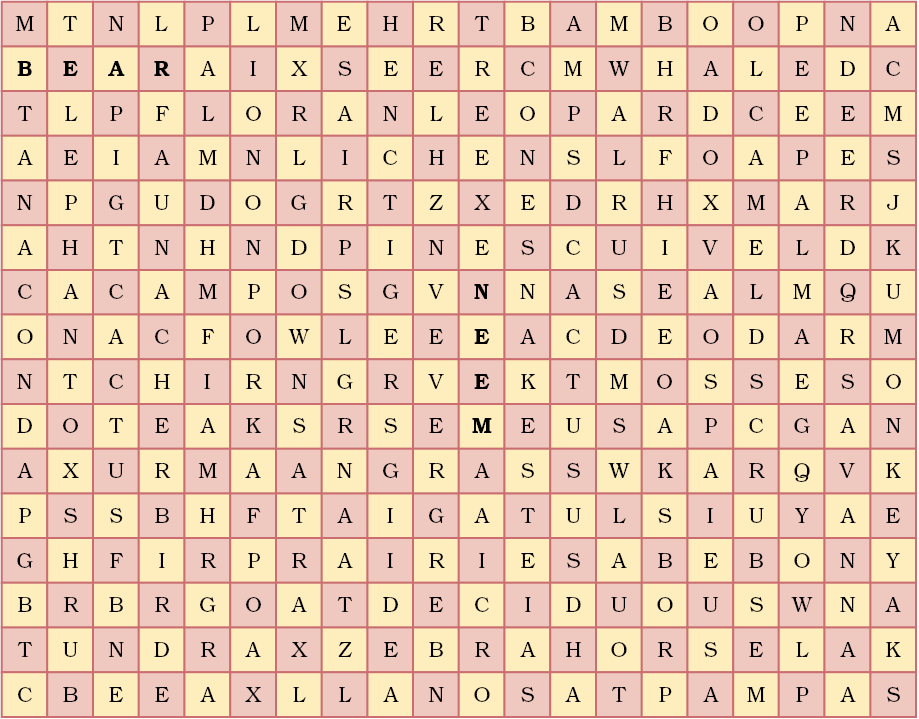Table of Contents


Salima was excited about the summer camp she was attending. She had gone to visit Manali in Himachal Pradesh along with her class mates. She recalled how surprised she was to see the changes in the landform and natural vegetation as the bus climbed higher and higher. The deep jungles of the foothills comprising sal and teak slowly disappeared. She could see tall trees with thin pointed leaves and cone shaped canopies on the mountain slopes. She learnt that those were coniferous trees. She noticed blooms of bright flowers on tall trees. These were the rhododendrons. From Manali as she was travelling up to Rohtang pass she saw that the land was covered with short grass and snow in some places.
Let's do
Now can you tell why Salima saw changes in the natural vegetation as she climbed higher and higher? What types of vegetations did she see in the Himalayas starting with the foothills and going to the higher altitudes?
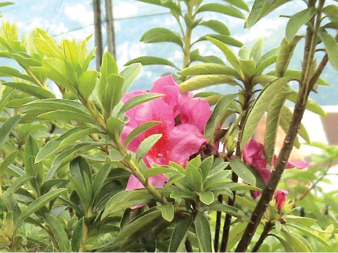
Fig. 6.1: Rhododendron
From Salima’s observations, we surmise that there is a close relationship between height of land and the character of vegetations. With the change in height, the climate changes and that changes natural vegetation. The growth of vegetation depends on temperature and moisture. It also depends on factors like slope and thickness of soil.
The type and thickness of natural vegetation varies from place to place because of the variation in these factors.
Let's do
• Like Salima, when you go to visit any new place, notice the type of natural vegetation occurring there and try to think of factors responsible for the growth of such vegetation in that habitat.
• Note down if any human interference has taken place in that area in terms of deforestation, grazing, cultivation of cash crops, constructional activities etc.
Natural vegetation is generally classified in to three broad categories as follows:
(a) Forests: Which grow where temperature and rainfall are plentiful to support a tree cover. Depending upon these factors, dense and open forests are grown.
(b) Grasslands: Which grow in the region of moderate rain.
(c) Shrubs: Thorny shrurbs and scrubs grow in the dry region (Fig. 6.2).
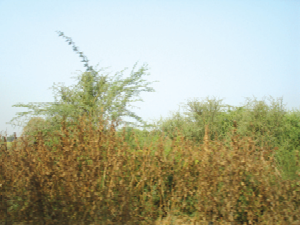
Salima was sharing her experience of Himalayan trip with her father. Her father visited various places in the world. He told Salima about his observations of the variety of vegetation in different parts of different continents.He mentioned about coniferous forests in the sub polar regions, thorny bushes in the deserts, thick tropical hardwood forest in the humid regions and many more. Salima realised the Himalayas have almost all variety of vegetation which one can see while moving from the equator to the polar region.
The changes in the type of natural vegetation occur mainly because of the changes of climatic condition. Let us get to know the different types of natural vegetation of the world with their characteristic features and wildlife inhabiting there.
Forests
Do you know?
The tropical evergreen forest in Brazil is so enormous that it is like the lungs of the earth: Can you tell why?
Tropical Evergreen Forests
These forests are also called tropical rainforests (Fig. 6.3). These thick forests occur in the regions near the equator and close to the tropics. These regions are hot and receive heavy rainfall throughout the year. As there is no particular dry season, the trees do not shed their leaves altogether. This is the reason they are called evergreen. The thick canopies of the closely spaced trees do not allow the sunlight to penetrate inside the forest even in the day time. Hardwood trees like rosewood, ebony, mahogany are common here.
Do you know?
sAnaconda, one of the world’s largest snakes is found in the tropical rainforest. It can kill and eat a large animal such as a crocodile.
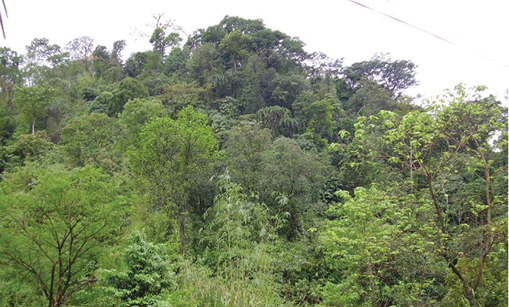
Fig. 6.3: A Tropical Evergreen Forest
Tropical Deciduous Forests
Tropical deciduous are the monsoon forests found in the large part of India,northern Australia and in central America (Fig. 6.4).These regions experience seasonal changes. Trees shed their leaves in the dry season to conserve water. The hardwood trees found in these forests are sal, teak, neem and shisham. Hardwood trees are extremely useful for making furniture, transport and constructional materials. Tigers, lions, elephants, langoors and monkeys are the common animals of these regions (Fig. 6.5, 6.6 and 6.8).
Let's do
• Where in India do tropical evergreen and tropical deciduous forests occur? Name the states.
• Which type of forest dominates most part of India?
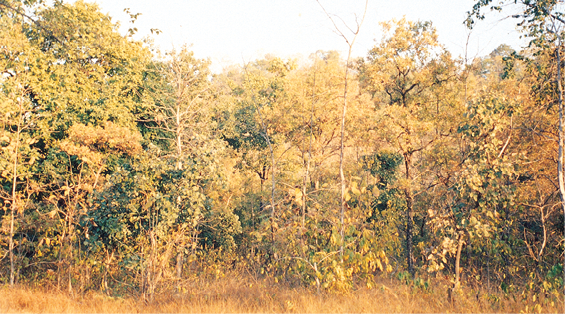
Fig. 6.4: A Tropical Deciduous Forest

Fig. 6.5: A Tiger
Temperate Evergreen Forests
The temperate evergreen forests are located in the mid-latitudinal coastal region (Fig. 6.7). They are commonly found along the eastern margin of the continents, e.g., In south east USA, South China and in South East Brazil. They comprise both hard and soft wood trees like oak, pine, eucalyptus, etc.

Fig. 6.6: A Golden Langoor
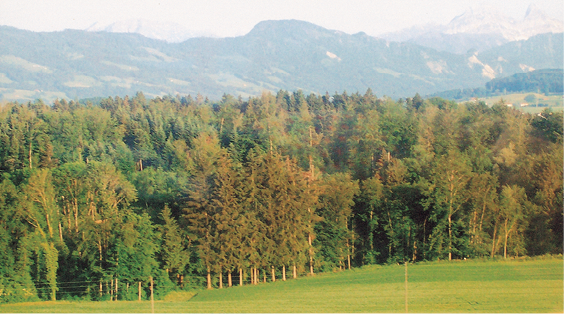
Fig. 6.7: A Temperate Evergreen Forest
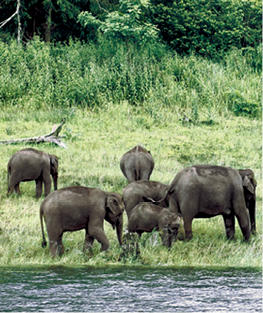
Fig. 6.8: Elephants
Temperate Deciduous Forests
As we go towards higher latitudes, there are more temperate deciduous forests (Fig. 6.11). These are found in the north eastern part of USA, China, New Zealand, Chile and also found in the coastal regions of Western Europe. They shed their leaves in the dry season. The common trees are oak, ash, beech, etc. Deer, foxes, wolves are the animals commonly found. Birds like pheasants, monals are also found here (Fig. 6.9 and 6.10).

Fig. 6.9: A Pheasant

Fig. 6.10: A Monal
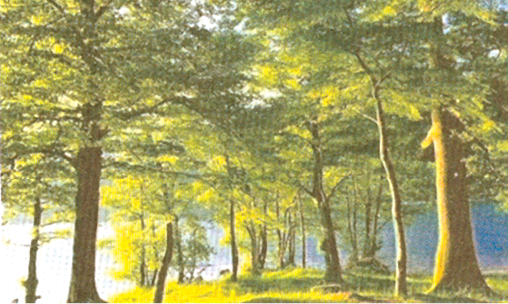
Fig. 6.11: A Temperate Deciduous Forest
Mediterranean Vegetation
You have learnt that most of the east and north east margins of the continents are covered by temperate evergreen and deciduous trees. The west and south west margins of the continents are different. They have Mediterranean vegetation (Fig. 6.12). It is mostly found in the areas around the Mediterranean sea in Europe, Africa and Asia, hence the name. This kind of vegetation is also found outside the actual Mediterranean region in California in the USA, south west Africa, south western South America and South west Australia. These regions are marked for hot dry summers and mild rainy winters. Citrus fruits such as oranges, figs, olives and grapes are commonly cultivated here because people have removed the natural vegetation in order to cultivate what they want to. There isn’t much wildlife here.
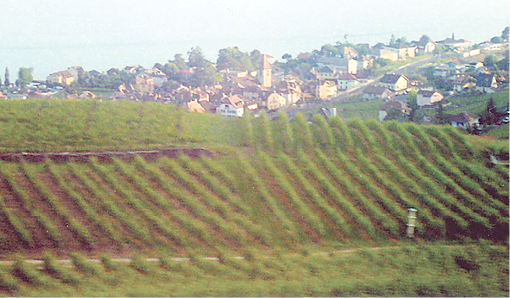
Fig. 6.12: A vineyard in the Mediterranean Region
• Mediterranean trees adapt themselves to
dry summers with the help of their thick barks and wax coated leaves which help them reduce transpiration.
• Mediterranean regions are known as ‘Orchards of the world’ for their fruit cultivation.
Coniferous Forests
Let's do
• Look around in your surroundings and find out the articles made of hard wood and soft wood.
• Find out and learn the names of few trees of your locality.
In the higher latitudes (50° – 70°) of Northern hemisphere the spectacular Coniferous forests are found (Fig. 6.13 a and b). These are also called as Taiga. These forests are also seen in the higher altitudes. These are the trees which Salima found in the Himalayas in abundance. They are tall, softwood evergreen trees. The woods of these trees are very useful for making pulp, which is used for manufacturing paper and newsprint. Match boxes and packing boxes are also made from softwood. Chir, pine, cedar are the important variety of trees in these forests. Silver fox, mink, polar bear are the common animals found here
.
Do you know?
Taiga means pure or untouched in the Russian language
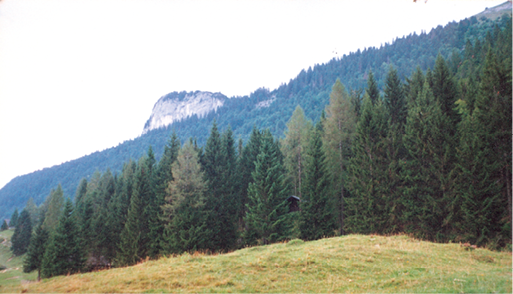
Fig. 6.13 (a): A Coniferous Forest

Fig. 6.13 (b): Snow covered Coniferous Forest
Grasslands
Tropical grasslands: These occur on either side of the equator and extend till the tropics (Fig. 6.14). This vegetation grows in the areas of moderate to low amount of rainfall. The grass can grow very tall, about 3 to 4 metres in height. Savannah grasslands of Africa are of this type. Elephants, zebras, giraffes, deer, leopards are common in tropical grasslands (Fig. 6.15).
Temperate grasslands: These are found in the mid- latitudinal zones and in the interior part of the continents. Usually, grass here is short and nutritious.Wild buffaloes, bisons, antilopes are common in the temperate region.
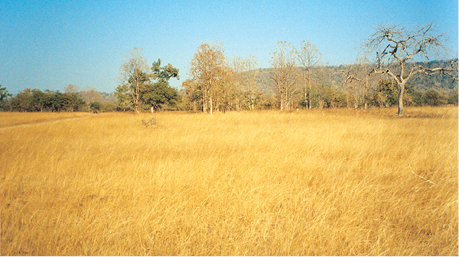
Fig. 6.14: Tropical Grassland
Thorny bushes: These are found in the dry desert like regions.Tropical deserts are located on the western margins of the continents. The vegetation cover is scarce here because of scanty rain and scorching heat. Identify the desert regions in the world map. Can you name the great desert of India? Name some of the common animals of the desert which you have learnt earlier.

Fig. 6.15: Giraffes
If you reach the polar region you will find the place extremely cold. The growth of natural vegetation is very limited here. Only mosses, lichens and very small shrubs are found here. It grows during the very short summer. This is called Tundra type of vegetation. This vegetation is found in the polar areas of Europe, Asia and North America. The animals have thick fur and thick skin to protect themselves from the cold climatic conditions. seal, walruses, musk-oxen, Arctic owl, Polar bear and snow foxes are some of the animals found here (Fig. 6.16).
Do you know?
Grasslands are known by different names in different regions.
Tropical Grasslands
East Africa-Savanna
Brazil-Campos
Venezuela-Llanos
Temperate Grasslands
Argentina- Pampas
N. America- Prairie
S. Africa- Veld
C. Asia- Steppe
Australia- Down
Salima’s father showed her some photographs of thick forests. In some of the photographs, Salima observed that people were cutting trees and clearing the forests. Her father explained that the local people wanted their land for agriculture and settlements, so they cleared up the forests. Salima started wondering if all forests are cleared, then where will the wild life go? Will the forest take its original shape again? If people go on cutting the trees like this, will there be enough oxygen, water vapour, timber, fruits, nuts available in future?
Do you agree with Salima? Hold a discussion with your friends about the depletion of our diversified flora and fauna. Suggest some measures to conserve them.
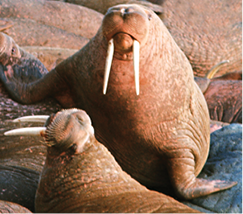
Walrus

Polar Bear
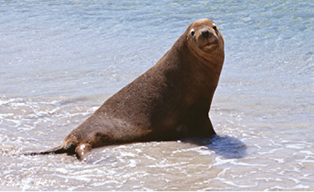
Seal
Fig. 6.16

1. Answer the following questions.
(i) Which are the two factors on which the growth of vegetation mostly depends?
(ii) Which are the three broad categories of natural vegetation?
(iii) Name the two hardwood trees commonly found in tropical evergreen forest.
(iv) In which part of the world are tropical deciduous forest found?
(v) In which climatic conditions are citrus fruits cultivated?
(vi) Mention the uses of coniferous forest.
(vii) In which part of the world is seasonal grassland found?
2. Tick the correct answer.
(i) Mosses and Lichens are found in:
(a) Desertic Vegetation
(b) Tropical evergreen forest
(c) Tundra vegetation
(ii) Thorny bushes are found in:
(a) Hot and humid tropical climate
(b) Hot and dry desertic climate
(c) Cold polar climate
(iii) In tropical evergreen forest, one of the common animals is:
(a) Monkey (b) Girraffe (c) Camel
(iv) One important variety of coniferous forest is:
(a) Rosewood (b) Pine (c) Teak
(v) Steppe grassland is found in
(a) S. Africa (b) Australia (c) Central Asia
3. Match the following.
(i) Walrus (a) Soft wood tree
(ii) Cedar (b) An animal of tropical deciduous forest
(iii) Olives (c) A polar animal
(iv) Elephants (d) Temperate grassland in Australia
(v) Campos (e) Thorny shrubs
(vi) Downs (f) A citrus fruit
(g) Tropical grassland of Brazil
4. Give reasons.
(i) The animals in polar region have thick fur and thick skin.
(ii) Tropical deciduous trees shed their leaves in the dry season.
(iii) The type and thickness of vegetation changes from place to place.
5. Activity.
(i) Collect pictures and photographs of forests and grasslands of different parts of world. Write one sentence below each picture.
(ii) Make a collage of rainforest, grassland and coniferous forests.
6. For fun.
In the crossword table given below, some words are hidden. They are all about vegetation and wildllife and are to be found horizontally and vertically. Two have been worked out for you. Work in pairs with a friend.
